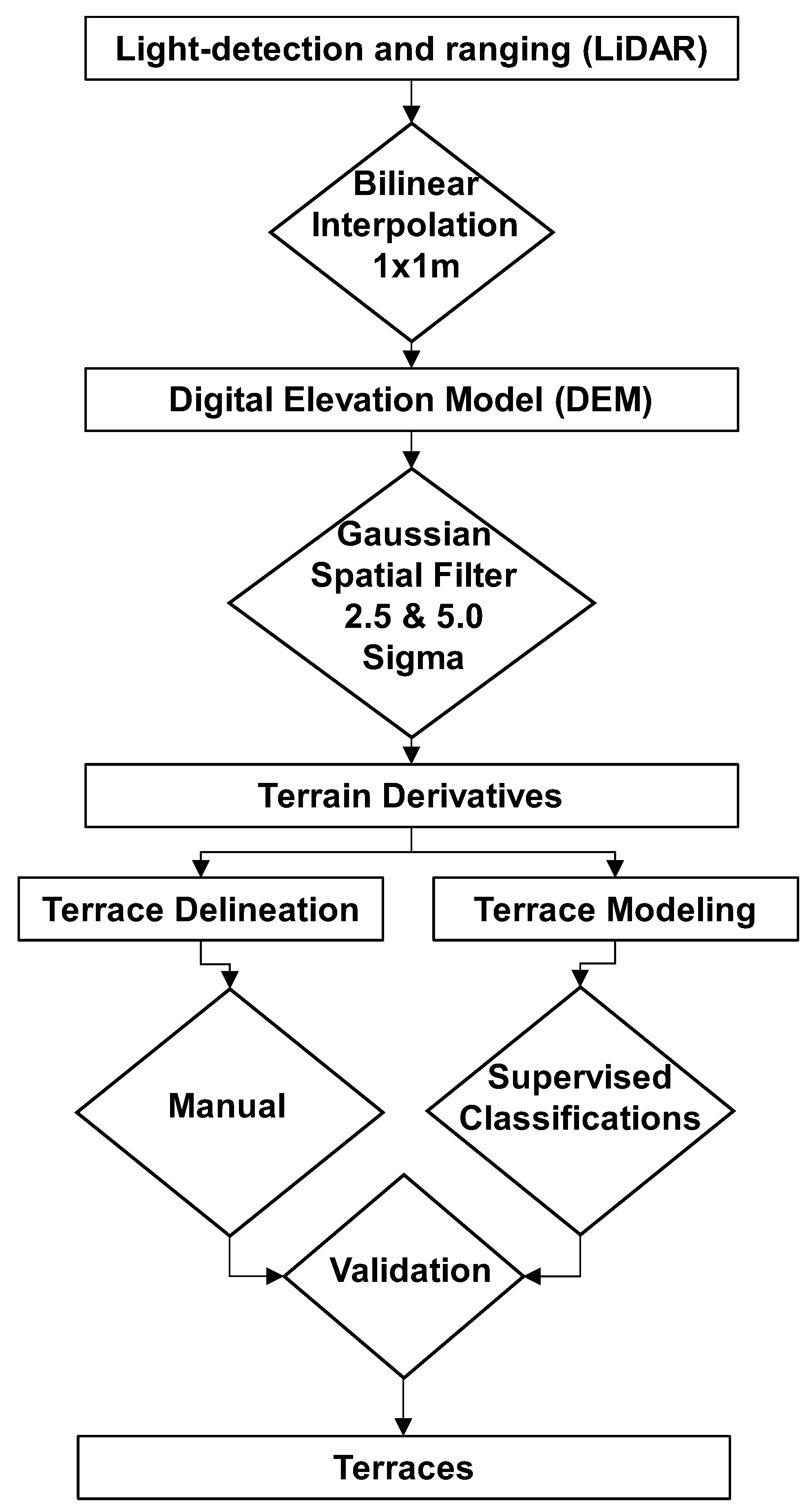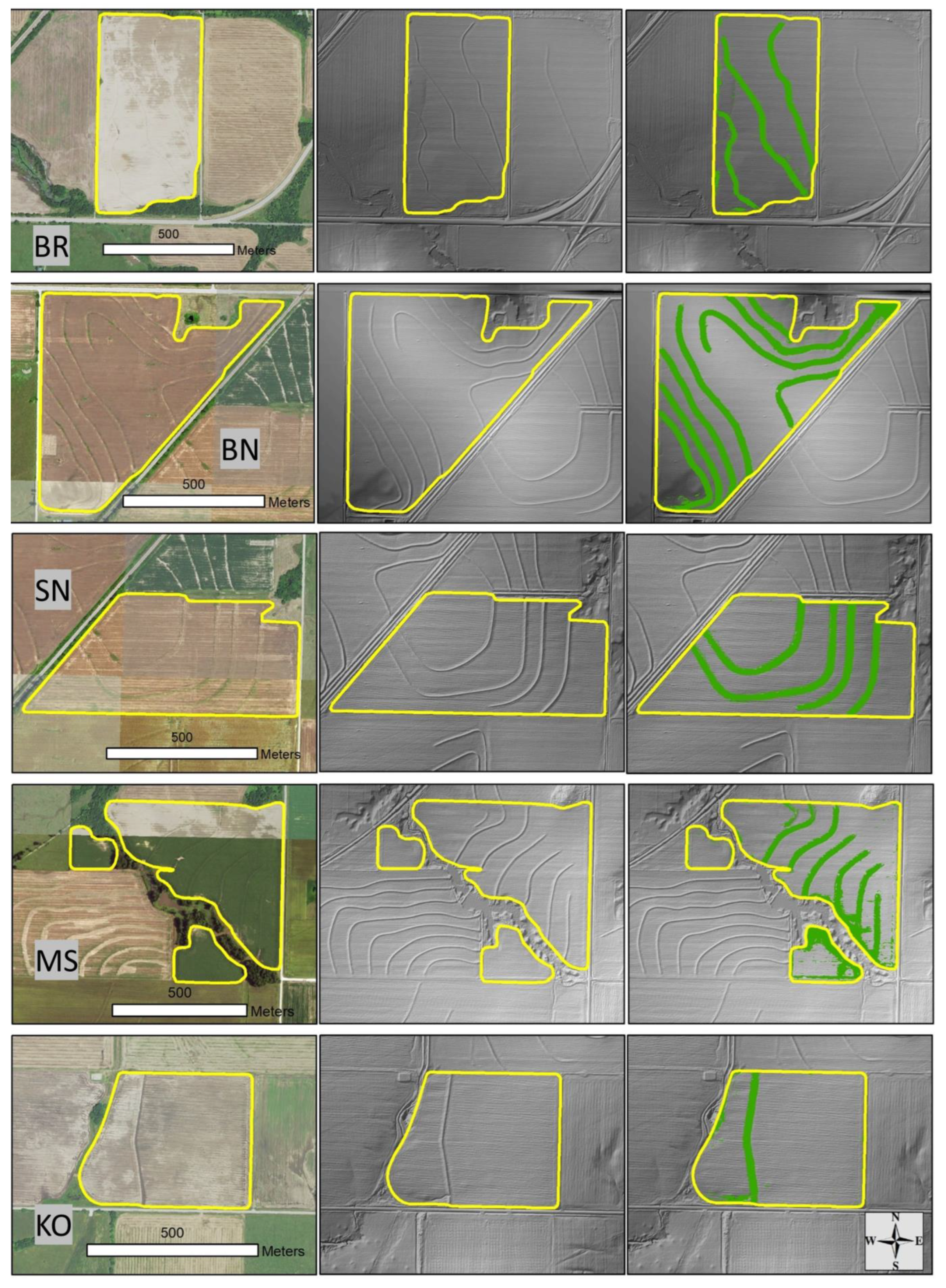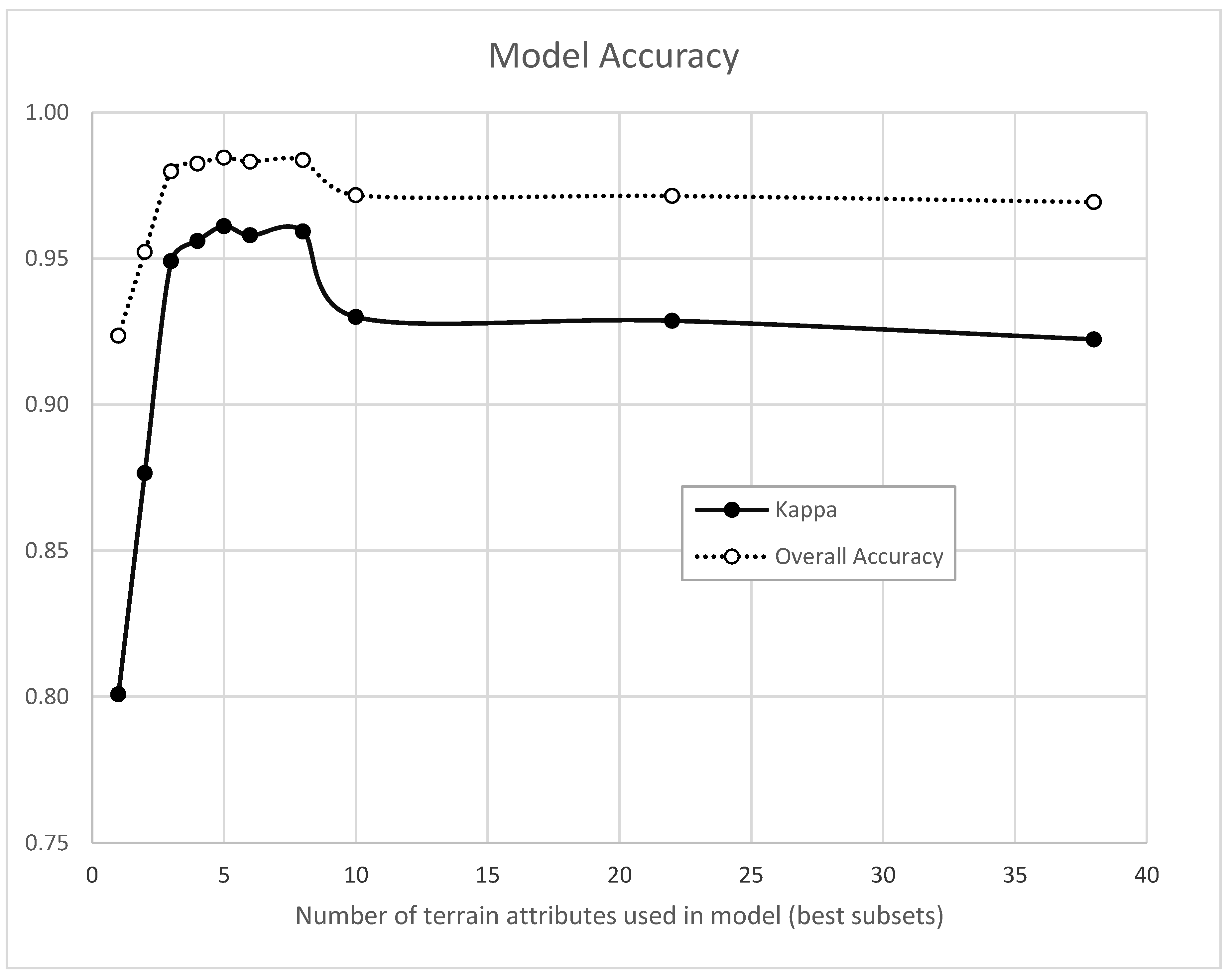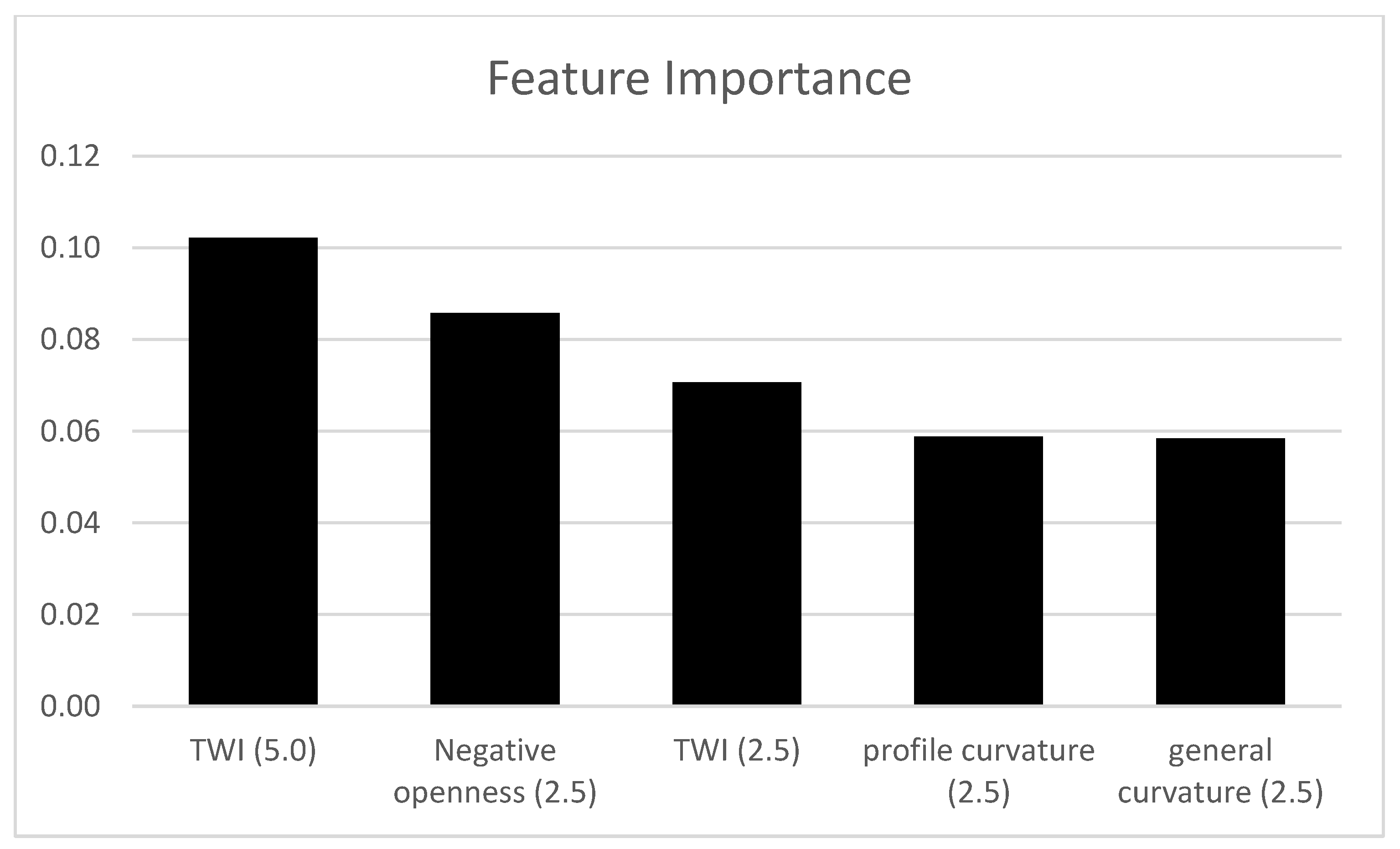Identification and Delineation of Broad-Base Agricultural Terraces in Flat Landscapes in Northeastern Oklahoma, USA
Abstract
1. Introduction
2. Materials and Methods
2.1. Study Sites
2.2. Data Sources and Processing
2.3. Terrace Modeling
2.4. Model Evaluation
3. Results
3.1. Terrace Characteristics
3.2. Terrace Delineation Accuracy
3.3. Terrace Delineation Response to Smoothing and Terrain Derivative Parameters
4. Discussion
5. Conclusions
Author Contributions
Funding
Institutional Review Board Statement
Informed Consent Statement
Data Availability Statement
Acknowledgments
Conflicts of Interest
References
- Deng, C.; Zhang, G.; Liu, Y.; Nie, X.; Li, Z.; Liu, J.; Zhu, D. Advantages and disadvantages of terracing: A comprehensive review. Int. Soil Water Conserv. Res. 2021, 9, 344–359. [Google Scholar] [CrossRef]
- Baryła, A.; Pierzgalski, E. Ridged terraces—Functions, construction and use. J. Environ. Eng. Landsc. Manag. 2008, 16, 104–109. [Google Scholar]
- Ferro-Vázquez, C.; Lang, C.; Kaal, J.; Stump, D. When is a terrace not a terrace? The importance of understanding landscape evolution in studies of terraced agriculture. J. Environ. Manag. 2017, 202, 500–513. [Google Scholar] [CrossRef]
- Wheaton, R.Z.; Monke, E. Terracing as a “Best Management Practice” for Controlling Erosion and Protecting Water Quality. 1981. Available online: https://www.extension.purdue.edu/extmedia/AE/AE-114.html#:~:text=What%20is%20terracing%3F%20Terracing%20is%20a%20soil%20conservation,Terraces%20consist%20of%20ridges%20and%20channels%20constructed%20across-the-slope (accessed on 19 July 2022).
- FAO; United Nations. Watershed Management Field Manual: Slope Treatment Measures and Practices; FAO: Rome, Italy, 1988. [Google Scholar]
- Winzeler, H.E.; Owens, P.R.; Waltman, S.W.; Waltman, W.J.; Libohova, Z.; Beaudette, D. A Methodology for Examining Changes in Soil Climate Geography through Time: U.S. Soil Moisture Regimes for the Period 1971–2000. Soil Sci. Soc. Am. J. 2013, 77, 213–225. [Google Scholar] [CrossRef]
- Dai, W.; Na, J.; Huang, N.; Hu, G.; Yang, X.; Tang, G.; Xiong, L.; Li, F. Integrated edge detection and terrain analysis for agricultural terrace delineation from remote sensing images. Int. J. Geogr. Inf. Sci. 2020, 34, 484–503. [Google Scholar] [CrossRef]
- Florinsky, I.V. Digital Terrain Analysis in Soil Science and Geology, 2nd ed.; Elsevier: Amsterdam, The Netherlands, 2016. [Google Scholar]
- Wilson, J.P. Environmental Applications of Digital Terrain Modeling; Wiley Blackwell: Hoboken, NJ, USA, 2018. [Google Scholar]
- Böhner, J.; Selige, T. Spatial prediction of soil attributes using terrain analysis and climate regionalisation. Göttinger Geogr. Abh. 2004, 115, 16. [Google Scholar]
- U.S. Geological Survey. 3D Elevation Program 1-Meter Resolution Digital Elevation Model (Published 20200606). 2022. Available online: https://www.usgs.gov/3d-elevation-program (accessed on 1 July 2022).
- Arundel, S.T.; Archuleta, C.A.M.; Phillips, L.A.; Roche, B.L.; Constance, E.W. 1-Meter Digital Elevation Model Specification; U.S. Geological Survey: Reston, VA, USA, 2015. [Google Scholar]
- Erdbrügger, J.; van Meerveld, I.; Bishop, K.; Seibert, J. Effect of DEM-smoothing and -aggregation on topographically-based flow directions and catchment boundaries. J. Hydrol. 2021, 602, 126717. [Google Scholar] [CrossRef]
- Winzeler, H.E.; Owens, P.R.; Read, Q.D.; Libohova, Z.; Ashworth, A.; Sauer, T. Topographic Wetness Index as a Proxy for Soil Moisture in a Hillslope Catena: Flow Algorithms and Map Generalization. Land 2022, 11, 2018. [Google Scholar] [CrossRef]
- Lindsay, J.B.; Creed, I. Removal of artifact depressions from digital elevation models: Towards a minimum impact approach. Hydrol. Process. 2005, 19, 3113–3126. [Google Scholar] [CrossRef]
- Zevenbergen, L.W.; Thorne, C.R. Quantitative analysis of land surface topography. Earth Surf. Process. Landf. 1987, 12, 47–56. [Google Scholar] [CrossRef]
- Olaya, V. Basic Land-Surface Parameters. Developments in Soil Science; Elsevier: Amsterdam, The Netherlands, 2009; Chapter 6; pp. 141–169. [Google Scholar]
- Conrad, O.; Bechtel, B.; Bock, M.; Dietrich, H.; Fischer, E.; Gerlitz, L.; Wehberg, J.; Wichmann, V.; Böhner, J. System for Automated Geoscientific Analyses (SAGA) v. 2.1.4. Geosci. Model Dev. 2015, 8, 1991–2007. [Google Scholar] [CrossRef]
- Guisan, A.; Weiss, S.B.; Weiss, A.D. GLM versus CCA spatial modeling of plant species distribution. Plant Ecol. 1999, 143, 107–122. [Google Scholar] [CrossRef]
- Gallant, J.C.; Dowling, T.I. A multiresolution index of valley bottom flatness for mapping depositional areas: MULTIRESOLUTION VALLEY BOTTOM FLATNESS. Water Resour. Res. 2003, 39, 1347. [Google Scholar] [CrossRef]
- Adhikari, K.; Owens, P.R.; Ashworth, A.J.; Sauer, T.J.; Libohova, Z.; Richter, J.L.; Miller, D.M. Topographic Controls on Soil Nutrient Variations in a Silvopasture System. Agrosyst. Geosci. Environ. 2018, 1, 1–15. [Google Scholar] [CrossRef]
- Freeman, T.G. Calculating catchment area with divergent flow based on a regular grid. Comput. Geosci. 1991, 17, 413–422. [Google Scholar] [CrossRef]
- Beven, K.J.; Kirkby, M.J. A physically based, variable contributing area model of basin hydrology / Un modèle à base physique de zone d’appel variable de l’hydrologie du bassin versant. Hydrol. Sci. Bull. 1979, 24, 43–69. [Google Scholar] [CrossRef]
- Yokoyama, R.; Shirasawa, M.; Pike, R. Visualizing topography by Openness: A new application of image processing to digital elevation models. Photogramm. Eng. Remote Sens. 2002, 68, 257–265. [Google Scholar]
- Hantzschel, J.; Goldberg, V.; Bernhofer, C. GIS-based regionalisation of radiation, temperature and coupling measures in complex terrain for low mountain ranges. Meteorol. Appl. 2005, 12, 33–42. [Google Scholar] [CrossRef]
- Böhner, J.; Antonić, O. Land-Surface Parameters Specific to Topo-Climatology. Developments in Soil Science; Elsevier: Amsterdam, The Netherlands, 2009; Chapter 8; pp. 195–226. [Google Scholar]
- Pulli, K.; Baksheev, A.; Kornyakov, K.; Eruhimov, V. Real-time computer vision with OpenCV. Commun. ACM 2012, 55, 61–69. [Google Scholar] [CrossRef]
- Breiman, L. Random Forests. Mach. Learn. 2001, 45, 5–32. [Google Scholar] [CrossRef]
- John, G.H.; Langley, P. Static versus Dynamic Sampling for Data Mining. In Proceedings of the Second International Conference on Knowledge Discovery and Data Mining, Portland, OR, USA, 2–4 August 1996. [Google Scholar]
- Kharel, T.P.; Ashworth, A.J.; Owens, P.R.; Philipp, D.; Thomas, A.L.; Sauer, T.J. Teasing Apart Silvopasture System Components Using Machine Learning for Optimization. Soil Syst. 2021, 5, 41. [Google Scholar] [CrossRef]
- Cohen, J. Weighted kappa: Nominal scale agreement provision for scaled disagreement or partial credit. Psychol. Bull. 1968, 70, 213–220. [Google Scholar] [CrossRef] [PubMed]
- USDA. National Agricultural Imagery Program. Available online: https://naip-usdaonline.hub.arcgis.com/ (accessed on 1 January 2023).
- Arnáez, J.; Lana-Renault, N.; Lasanta, T.; Ruiz-Flaño, P.; Castroviejo, J. Effects of farming terraces on hydrological and geomorphological processes. A review. Catena 2015, 128, 122–134. [Google Scholar] [CrossRef]
- El Atta, H.A.; Aref, I. Effect of terracing on rainwater harvesting and growth of Juniperus procera Hochst. ex Endlicher. Int. J. Environ. Sci. Technol. 2010, 7, 59–66. [Google Scholar] [CrossRef]
- Lesschen, J.P.; Cammeraat, L.; Nieman, T. Erosion and terrace failure due to agricultural land abandonment in a semi-arid environment. Earth Surf. Process. Landf. 2008, 33, 1574–1584. [Google Scholar] [CrossRef]
- Wei, W.; Chen, D.; Wang, L.; Daryanto, S.; Chen, L.; Yu, Y.; Lu, Y.; Sun, G.; Feng, T. Global synthesis of the classifications, distributions, benefits and issues of terracing. Earth-Sci. Rev. 2016, 159, 388–403. [Google Scholar] [CrossRef]
- Hass, H.J.; Willis, W.O.; Boatwright, G.O. Moisture storage and spring wheat yields on level-bench terraces as influenced by contributing area cover and evaporation control. Agron. J. 1966, 58, 297–299. [Google Scholar] [CrossRef]
- Sharda, V.N.; Sena, D.R.; Shrimali, S.S.; Khola, O.P.S. Effects of an Intercrop-Based Conservation Bench Terrace System on Resource Conservation and Crop Yields in a Sub-Humid Climate in India. Trans. ASABE 2013, 56, 1411–1425. [Google Scholar] [CrossRef]
- Wickama, J.; Okoba, B.; Sterk, G. Effectiveness of sustainable land management measures in West Usambara highlands, Tanzania. Catena 2014, 118, 91–102. [Google Scholar] [CrossRef]
- Adgo, E.; Teshome, A.; Mati, B. Impacts of long-term soil and water conservation on agricultural productivity: The case of Anjenie watershed, Ethiopia. Agric. Water Manag. 2013, 117, 55–61. [Google Scholar] [CrossRef]
- Kagabo, D.M.; Stroosnijder, L.; Visser, S.M.; Moore, D. Soil erosion, soil fertility and crop yield on slow-forming terraces in the highlands of Buberuka, Rwanda. Soil Tillage Res. 2013, 128, 23–29. [Google Scholar] [CrossRef]
- Brady, N.C.; Weil, R.R. The Nature and Properties of Soils, 13th ed.; Prentice Hall: Upper Saddle River, NJ, USA, 2002. [Google Scholar]






| Terrain Derivatives | Type | Description | Source |
|---|---|---|---|
| Slope | Morphometric | Change in elevation over distance | [16] |
| Plan curvature | Morphometric | Rate of change in slope orthogonal to direction of steepest slope | [16] |
| Profile curvature | Morphometric | Rate of change in slope down a flow line | [16] |
| Tangential curvature | Morphometric | Plan curvature multiplied by the sine of the slope angle | [16] |
| General curvature | Morphometric | General curvature of the surface | [17] |
| Aspect | Morphometric | Radial direction of maximum downward gradient | [16] |
| Convergence index | Morphometric | Average bias of slope directions of adjacent cells | [18] |
| Topographic position index | Morphometric | Difference between a cell’s elevation and the mean elevation calculated for surrounding cells | [19] |
| Multi-resolution index of valley-bottom flatness | Morphometric | Degree of similarity between the pixel and a class of flat low-lying areas | [20] |
| Slope height | Morphometric | Relative height difference to the immediately adjacent crest lines | [10] [21] |
| Valley depth | Morphometric | Relative height difference to the immediately adjacent channel lines | [10] [21] |
| Standardized height | Morphometric | Elevation raster with standardized histogram of values | [10] |
| Flow accumulation | Hydrological | Area of upland cells draining to a given cell, assuming multi-directional downhill flow | [22] |
| Specific catchment area | Hydrological | Upslope-contributing area divided by the contour width | [9,22] |
| Topographic wetness index | Hydrological | Specific catchment area divided by the natural logarithm of the slope (multiple-flow-direction method, convergence index = 1.1) | [22,23] |
| Morphometric protection index | Visibility | Lowness of the central cell relative to surrounding cells within a specified distance | [17] |
| Negative terrain openness | Visibility | Angular measure of the relation between surface relief and horizontal distance constrained by surrounding elevation | [24] |
| Sky view factor | Visibility | The ratio of diffuse irradiance at a pixel to that on an unobstructed horizontal surface | [25] |
| Visible sky | Visibility | The percentage of the hemisphere that is visually unobstructed by surrounding terrain | [26] |
| -----Elevation----- | |||||
|---|---|---|---|---|---|
| Site | High | Low | Change | Distance | Slope |
| -----------------meters----------------- | -%- | ||||
| BR | 257.2 | 253.1 | 4.1 | 823 | 0.50 |
| BN | 258.5 | 254.7 | 3.8 | 490 | 0.78 |
| SN | 258.7 | 255.8 | 2.9 | 665 | 0.44 |
| MS | 262.0 | 255.8 | 6.2 | 817 | 0.76 |
| KO | 259.6 | 255.5 | 4.1 | 549 | 0.75 |
Disclaimer/Publisher’s Note: The statements, opinions and data contained in all publications are solely those of the individual author(s) and contributor(s) and not of MDPI and/or the editor(s). MDPI and/or the editor(s) disclaim responsibility for any injury to people or property resulting from any ideas, methods, instructions or products referred to in the content. |
© 2023 by the authors. Licensee MDPI, Basel, Switzerland. This article is an open access article distributed under the terms and conditions of the Creative Commons Attribution (CC BY) license (https://creativecommons.org/licenses/by/4.0/).
Share and Cite
Winzeler, H.E.; Owens, P.R.; Kharel, T.; Ashworth, A.; Libohova, Z. Identification and Delineation of Broad-Base Agricultural Terraces in Flat Landscapes in Northeastern Oklahoma, USA. Land 2023, 12, 486. https://doi.org/10.3390/land12020486
Winzeler HE, Owens PR, Kharel T, Ashworth A, Libohova Z. Identification and Delineation of Broad-Base Agricultural Terraces in Flat Landscapes in Northeastern Oklahoma, USA. Land. 2023; 12(2):486. https://doi.org/10.3390/land12020486
Chicago/Turabian StyleWinzeler, Hans Edwin, Phillip R. Owens, Tulsi Kharel, Amanda Ashworth, and Zamir Libohova. 2023. "Identification and Delineation of Broad-Base Agricultural Terraces in Flat Landscapes in Northeastern Oklahoma, USA" Land 12, no. 2: 486. https://doi.org/10.3390/land12020486
APA StyleWinzeler, H. E., Owens, P. R., Kharel, T., Ashworth, A., & Libohova, Z. (2023). Identification and Delineation of Broad-Base Agricultural Terraces in Flat Landscapes in Northeastern Oklahoma, USA. Land, 12(2), 486. https://doi.org/10.3390/land12020486







